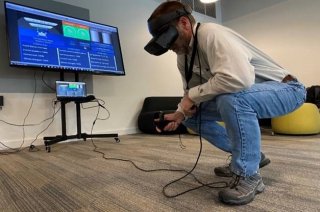Training through Immersive Technology

The EPA plays a crucial role in contamination cleanup and remediation efforts. This includes responding to incidents such as chemical spills, hazardous waste sites, and biological threats. The agency's mission is to safeguard human health and the environment by managing and mitigating the impacts of these hazardous events.
Researchers are evaluating the impact and usefulness of virtual reality (VR) in training personnel for disaster response. Traditional training exercises can be expensive, time consuming, and difficult to organize. Immersive technology may address these challenges while providing trainees a safe way to practice cleanup techniques.
On this Page:
- What is Immersive Technology?
- Types of Immersive Technologies
- Immersive Technology Objectives
- Training Simulators and Platforms
- Additional Resources
- Technical Assistance
What is Immersive Technology?
Immersive technology allows a person to engage in a virtual reality environment. This technology can use software called serious games that are designed primarily for education, training, or problem-solving. These games use engaging and interactive play to simulate real-world processes or environments.
Serious games present innovative ways for training personnel involved in responding to contamination incidents. Here's how:
- Immersive Learning with VR: VR is a simulated, immersive environment that users can explore and interact with through a head-mounted display and optional handheld controllers. Studies have found that sensory-motor tasks learned in VR can be transferred to real-life environments. In some cases, VR-trained personnel perform better than those who trained in the field.
- Performance Tracking: VR provides the ability to track movements and actions, including body position and head direction. This offers a wealth of information about where users are focusing their attention, what they observe from their perspective, and their reactions to the environment.
- Assessment and Feedback: It provides a way to assess performance in tasks. Trainers can evaluate and provide feedback based on detailed data collected during the simulation.
- Cost and Safety Benefits: It reduces the burden associated with planning and conducting full-scale disaster exercises. Users can explore and interact with their environment while remaining outside potentially contaminated response areas.
Types of Immersive Technologies
Understanding the difference between VR, Augmented Reality, and Mixed Reality is essential:
- VR: Immerses the user in a fully digital environment, blocking out the real world. Users interact through head-mounted displays and controllers, experiencing a simulated world that can replicate real or imagined settings.
- Augmented Reality (AR): Overlays digital information onto the real-world environment. Using devices like smartphones or AR glasses, users see the real world enhanced with images, text, or animations.
- Mixed Reality (MR): Combines VR and AR, allowing real and virtual elements to interact in real-time. Users can control both physical and digital objects, blurring the line between real and virtual environments.
Immersive Technology Objectives
The EPA aims to collaborate with partners to develop cutting-edge training platforms utilizing VR, AR, and MR technologies. The objectives include:
- Enhancing Teamwork: Simulating real-world scenarios encourages collaborative problem-solving and communication among team members in a risk-free environment.
- Increasing Engagement: Interactive and immersive technologies make training more engaging, improving retention and motivation among personnel.
- Facilitating Learning: Providing hands-on experience with complex tasks enhances the learning process and skill acquisition, crucial for effective contamination response.
Training Simulators and Platforms
EPA is developing immersive technologies to train personnel for disaster response. These virtual environments allow users to practice in risk-free environments while learning how to perform vital tasks during incident response.
-
Biological Sampling Training Simulator
Train to Collect Biological Surface Samples
Hardware Required: Oculus Rift S
Computer: Tethered Computer, Supports High-end Graphics
-
Chemical Sampling Training Simulator
Train to Collect Chemical Samples
Hardware Required: Meta Quest 2 VR Headset
-
Radiological Sampling Training Simulator
Train to Measure Radiation and Dose
Hardware Required: Meta Quest 2 VR Headset
-
EPA FlightSim
Train to Identify Oil Spills and Debris during Aerial Reconnaissance
Hardware Required: Meta Quest 2 VR Headset
Software Required: Microsoft Flight Simulator
Computer: Tethered Computer, Supports High-end Graphics
-
Mini Game: Walk the Pirate Plank
Test Trainee Knowledge through a Question and Answer Quiz
Hardware Required: Meta Quest 2 VR Headset
-
Mini Game: Waste Dash
Test Waste Management Strategy through Competition. Trainees race against time to characterize waste and score the highest points.
Hardware Required: Meta Quest 2 VR Headset
Additional Resources
- EPA Researchers Design Virtual Reality Software to Prepare for Sampling in a Hazardous Environment
- Virtual Reality: A Training Tool for Biological Sampling Webinar
Technical Assistance
For additional information about these training simulators and platforms, please contact Timothy Boe (Boe.Timothy@epa.gov).
Any mention of trade names, manufacturers or products does not imply an endorsement by the United States Government or the U.S. Environmental Protection Agency. EPA and its employees do not endorse any commercial products, services, or enterprises.
